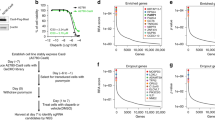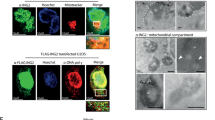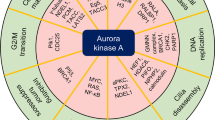Abstract
Release from growth factor dependence and acquisition of signalling pathway addiction are critical steps in oncogenesis. To identify genes required on mammalian target of rapamycin (mTOR) addiction, we performed a genome-wide short hairpin RNA screen on a v-H-ras-transformed Pten-deficient cell line that displayed two alternative growth modes, interleukin (IL)-3-independent/mTOR-addicted proliferation (transformed growth mode) and IL-3-dependent/mTOR-non-addicted proliferation (normal growth mode). We screened for genes required only in the absence of IL-3 and thus specifically for the transformed growth mode. The top 800 hits from this conditional lethal screen were analyzed in silico and 235 hits were subsequently rescreened in two additional Pten-deficient cell lines to generate a core set of 47 genes. Hits included genes encoding mTOR and the mTOR complex 2 (mTORC2) component rictor and several genes encoding mitochondrial functions including components of the respiratory chain, adenosine triphosphate synthase, the mitochondrial ribosome and mitochondrial fission factor. Small interfering RNA knockdown against a sizeable fraction of these genes triggered apoptosis in human cancer cell lines but not in normal fibroblasts. We conclude that mTORC2-addicted cells require mitochondrial functions that may be novel drug targets in human cancer.
This is a preview of subscription content, access via your institution
Access options
Subscribe to this journal
Receive 50 print issues and online access
$259.00 per year
only $5.18 per issue
Buy this article
- Purchase on Springer Link
- Instant access to full article PDF
Prices may be subject to local taxes which are calculated during checkout






Similar content being viewed by others
References
Alto NM, Soderling J, Scott JD . (2002). Rab32 is an A-kinase anchoring protein and participates in mitochondrial dynamics. J Cell Biol 158: 659–668.
Bandyopadhyay G, Sajan MP, Kanoh Y, Standaert ML, Quon MJ, Reed BC et al. (2001). Glucose activates protein kinase C-zeta/lambda through proline-rich tyrosine kinase-2, extracellular signal-regulated kinase, and phospholipase D: a novel mechanism for activating glucose transporter translocation. J Biol Chem 276: 35537–35545.
Bauer DE, Harris MH, Plas DR, Lum JJ, Hammerman PS, Rathmell JC et al. (2004). Cytokine stimulation of aerobic glycolysis in hematopoietic cells exceeds proliferative demand. FASEB J 18: 1303–1305.
Bentzinger CF, Romanino K, Cloetta D, Lin S, Mascarenhas JB, Oliveri F et al. (2008). Skeletal muscle-specific ablation of raptor, but not of rictor, causes metabolic changes and results in muscle dystrophy. Cell Metab 8: 411–424.
Chiang GG, Abraham RT . (2007). Targeting the mTOR signaling network in cancer. Trends Mol Med 13: 433–442.
Cunningham JT, Rodgers JT, Arlow DH, Vazquez F, Mootha VK, Puigserver P . (2007). mTOR controls mitochondrial oxidative function through a YY1-PGC-1alpha transcriptional complex. Nature 450: 736–740.
Dang CV . (2010). p32 (C1QBP) and cancer cell metabolism: is the Warburg effect a lot of hot air? Mol Cell Biol 30: 1300–1302.
Fan Y, Dickman KG, Zong WX . (2010). Akt and c-Myc differentially activate cellular metabolic programs and prime cells to bioenergetic inhibition. J Biol Chem 285: 7324–7333.
Fantin VR, Leder P . (2006). Mitochondriotoxic compounds for cancer therapy. Oncogene 25: 4787–4797.
Foster DA . (2007). Regulation of mTOR by phosphatidic acid? Cancer Res 67: 1–4.
Gandre-Babbe S, van der Bliek AM . (2008). The novel tail-anchored membrane protein Mff controls mitochondrial and peroxisomal fission in mammalian cells. Mol Biol Cell 19: 2402–2412.
Gonez LJ, Naselli G, Banakh I, Niwa H, Harrison LC . (2008). Pancreatic expression and mitochondrial localization of the progestin-adipoQ receptor PAQR10. Mol Med 14: 697–704.
Grandori C, Mac J, Siebelt F, Ayer DE, Eisenman RN . (1996). Myc-Max heterodimers activate a DEAD box gene and interact with multiple E box-related sites in vivo. EMBO J 15: 4344–4357.
Guertin DA, Sabatini DM . (2007). Defining the role of mTOR in cancer. Cancer Cell 12: 9–22.
Heyward CA, Pettitt TR, Leney SE, Welsh GI, Tavare JM, Wakelam MJ . (2008). An intracellular motif of GLUT4 regulates fusion of GLUT4-containing vesicles. BMC Cell Biol 9: 25.
Hill MM, Clark SF, Tucker DF, Birnbaum MJ, James DE, Macaulay SL . (1999). A role for protein kinase Bbeta/Akt2 in insulin-stimulated GLUT4 translocation in adipocytes. Mol Cell Biol 19: 7771–7781.
Jung HC, Kim K . (2005). Identification of MYCBP as a beta-catenin/LEF-1 target using DNA microarray analysis. Life Sci 77: 1249–1262.
Kiser KF, Colombi M, Moroni C . (2006). Isolation and characterization of dominant and recessive IL-3-independent hematopoietic transformants. Oncogene 25: 6595–6603.
Lipscomb EA, Sarmiere PD, Freeman RS . (2001). SM-20 is a novel mitochondrial protein that causes caspase-dependent cell death in nerve growth factor-dependent neurons. J Biol Chem 276: 5085–5092.
Luo B, Cheung HW, Subramanian A, Sharifnia T, Okamoto M, Yang X et al. (2008). Highly parallel identification of essential genes in cancer cells. Proc Natl Acad Sci USA 105: 20380–20385.
Luo J, Emanuele MJ, Li D, Creighton CJ, Schlabach MR, Westbrook TF et al. (2009). A genome-wide RNAi screen identifies multiple synthetic lethal interactions with the Ras oncogene. Cell 137: 835–848.
Majumder PK, Febbo PG, Bikoff R, Berger R, Xue Q, McMahon LM et al. (2004). mTOR inhibition reverses Akt-dependent prostate intraepithelial neoplasia through regulation of apoptotic and HIF-1-dependent pathways. Nat Med 10: 594–601.
Moffat J, Grueneberg DA, Yang X, Kim SY, Kloepfer AM, Hinkle G et al. (2006). A lentiviral RNAi library for human and mouse genes applied to an arrayed viral high-content screen. Cell 124: 1283–1298.
Muller BA . (2009). Imatinib and its successors--how modern chemistry has changed drug development. Curr Pharm Des 15: 120–133.
Murray JT, Campbell DG, Morrice N, Auld GC, Shpiro N, Marquez R et al. (2004). Exploitation of KESTREL to identify NDRG family members as physiological substrates for SGK1 and GSK3. Biochem J 384: 477–488.
Nair AP, Hirsch HH, Moroni C . (1992). Mast cells sensitive to v-H-ras transformation are hyperinducible for interleukin 3 expression and have lost tumor-suppressor activity. Oncogene 7: 1963–1972.
Nilsson R, Schultz IJ, Pierce EL, Soltis KA, Naranuntarat A, Ward DM et al. (2009). Discovery of genes essential for heme biosynthesis through large-scale gene expression analysis. Cell Metab 10: 119–130.
Pagliarini DJ, Calvo SE, Chang B, Sheth SA, Vafai SB, Ong SE et al. (2008). A mitochondrial protein compendium elucidates complex I disease biology. Cell 134: 112–123.
Polak P, Cybulski N, Feige JN, Auwerx J, Ruegg MA, Hall MN . (2008). Adipose-specific knockout of raptor results in lean mice with enhanced mitochondrial respiration. Cell Metab 8: 399–410.
Pytel D, Sliwinski T, Poplawski T, Ferriola D, Majsterek I . (2009). Tyrosine kinase blockers: new hope for successful cancer therapy. Anticancer Agents Med Chem 9: 66–76.
Ramanathan A, Schreiber SL . (2009). Direct control of mitochondrial function by mTOR. Proc Natl Acad Sci USA 106: 22229–22232.
Root DE, Hacohen N, Hahn WC, Lander ES, Sabatini DM . (2006). Genome-scale loss-of-function screening with a lentiviral RNAi library. Nat Methods 3: 715–719.
Sato T, Nakashima A, Guo L, Coffman K, Tamanoi F . (2010). Single amino-acid changes that confer constitutive activation of mTOR are discovered in human cancer. Oncogene 29: 2746–2752.
Schieke SM, Phillips D, McCoy Jr JP, Aponte AM, Shen RF, Balaban RS et al. (2006). The mammalian target of rapamycin (mTOR) pathway regulates mitochondrial oxygen consumption and oxidative capacity. J Biol Chem 281: 27643–27652.
Schlabach MR, Luo J, Solimini NL, Hu G, Xu Q, Li MZ et al. (2008). Cancer proliferation gene discovery through functional genomics. Science 319: 620–624.
Scholl C, Frohling S, Dunn IF, Schinzel AC, Barbie DA, Kim SY et al. (2009). Synthetic lethal interaction between oncogenic KRAS dependency and STK33 suppression in human cancer cells. Cell 137: 821–834.
Solimini NL, Luo J, Elledge SJ . (2007). Non-oncogene addiction and the stress phenotype of cancer cells. Cell 130: 986–988.
Soria JC, Lee HY, Lee JI, Wang L, Issa JP, Kemp BL et al. (2002). Lack of PTEN expression in non-small cell lung cancer could be related to promoter methylation. Clin Cancer Res 8: 1178–1184.
Thaimattam R, Banerjee R, Miglani R, Iqbal J . (2007). Protein kinase inhibitors: structural insights into selectivity. Curr Pharm Des 13: 2751–2765.
van de Wetering M, Oving I, Muncan V, Pon Fong MT, Brantjes H, van Leenen D et al. (2003). Specific inhibition of gene expression using a stably integrated, inducible small-interfering-RNA vector. EMBO Rep 4: 609–615.
Wang Q, Somwar R, Bilan PJ, Liu Z, Jin J, Woodgett JR et al. (1999). Protein kinase B/Akt participates in GLUT4 translocation by insulin in L6 myoblasts. Mol Cell Biol 19: 4008–4018.
Weinberg F, Chandel NS . (2009). Mitochondrial metabolism and cancer. Ann NY Acad Sci 1177: 66–73.
Weinberg F, Hamanaka R, Wheaton WW, Weinberg S, Joseph J, Lopez M et al. (2010). Mitochondrial metabolism and ROS generation are essential for Kras-mediated tumorigenicity. Proc Natl Acad Sci USA 107: 8788–8793.
Wise DR, DeBerardinis RJ, Mancuso A, Sayed N, Zhang XY, Pfeiffer HK et al. (2008). Myc regulates a transcriptional program that stimulates mitochondrial glutaminolysis and leads to glutamine addiction. Proc Natl Acad Sci USA 105: 18782–18787.
Wittwer AJ, Wagner C . (1980). Identification of folate binding protein of mitochondria as dimethylglycine dehydrogenase. Proc Natl Acad Sci USA 77: 4484–4488.
Wullschleger S, Loewith R, Hall MN . (2006). TOR signaling in growth and metabolism. Cell 124: 471–484.
Acknowledgements
We thank TW Sturgill for comments and Dr F Wenzel for providing normal human fibroblasts. We acknowledge support from the Commission of Technology and Innovation (CTI) (CM, MNH and UR), the Swiss National Science Foundation (CM and MNH) and the Swiss Cancer League and the Louis-Jeantet Foundation (MNH).
Author information
Authors and Affiliations
Corresponding authors
Ethics declarations
Competing interests
CM is a consultant for Actelion Ltd.
Additional information
Supplementary Information accompanies the paper on the Oncogene website
Supplementary information
Rights and permissions
About this article
Cite this article
Colombi, M., Molle, K., Benjamin, D. et al. Genome-wide shRNA screen reveals increased mitochondrial dependence upon mTORC2 addiction. Oncogene 30, 1551–1565 (2011). https://doi.org/10.1038/onc.2010.539
Received:
Revised:
Accepted:
Published:
Issue Date:
DOI: https://doi.org/10.1038/onc.2010.539
Keywords
This article is cited by
-
Senescence and aging: the critical roles of p53
Oncogene (2013)
-
Rapamycin passes the torch: a new generation of mTOR inhibitors
Nature Reviews Drug Discovery (2011)



